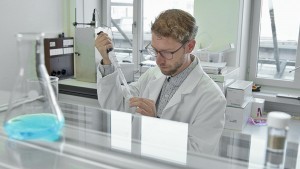Researchers at Empa and Lidl Switzerland have developed a protective cellulose layer for fruit and vegetables. It is made from pomace - pressed fruit and vegetable peelings. The project can reduce packaging and avoid food waste.
Plastic packaging in the food trade protects fruit and vegetables from spoiling, but also generates considerable amounts of waste. Together with the Swiss Federal Laboratories for Materials Science and Technology Empa, the food discounter Lidl Switzerland has now developed a protective cover for fruit and vegetables that is based on renewable raw materials. Lidl Switzerland chose Empa as a partner for its latest project because of its decades of research experience with cellulose products.
Longer shelf life at home
 This pomace from carrots can later be processed into cellulose material for coatingIn theEmpa Cellulose & Wood Materials laboratory, the researchers then spent more than a year developing a special protective cellulose layer that can be applied to fruit and vegetables on behalf of Lidl Switzerland. The result: the coated fruit and vegetables stay fresh significantly longer. In tests, the shelf life of bananas was extended by over a week. This significantly reduces food waste. "The big goal is that such natural coatings will be able to replace a lot of petroleum-based packaging in the future," says Gustav Nyström, head of the empa research department.
This pomace from carrots can later be processed into cellulose material for coatingIn theEmpa Cellulose & Wood Materials laboratory, the researchers then spent more than a year developing a special protective cellulose layer that can be applied to fruit and vegetables on behalf of Lidl Switzerland. The result: the coated fruit and vegetables stay fresh significantly longer. In tests, the shelf life of bananas was extended by over a week. This significantly reduces food waste. "The big goal is that such natural coatings will be able to replace a lot of petroleum-based packaging in the future," says Gustav Nyström, head of the empa research department.
Production from press residues and waste materials
In future, it is primarily so-called pomace that is to be processed into fibrillated cellulose. Pomace is the solid residue that remains after pressing the juice from fruit, vegetables or plants. Until now, these plant residues have been disposed of in biogas plants or directly on the field. In future, these residues will be used to produce the protective coating for fresh fruit. Depending on the results of the study, the coating will either be sprayed onto the fruit or applied to the products as an immersion bath and is easy to wash off. As it is harmless to the consumer, it can also be consumed without any problems. The potential of the cellulose coating is far from exhausted: it is possible to add additives such as vitamins or antioxidants.
Widespread use planned
This summer, the promising preliminary study, which has been running since 2019, was successfully completed and the main study started. The cellulose layer developed at Empa will be tested and further improved over the next two years together with Lidl Switzerland and a fruit and vegetable supplier. The project is financially supported by the Swiss Innovation Agency (Innosuisse). The aim is for the new technology to be used in all 150 Lidl stores in Switzerland following the successful main study.
INFO
 Empa researcher Kevin DeFrance is working on ecological packaging for fresh fruit and vegetables How ecological are plastic wrappers for cucumbers?
Empa researcher Kevin DeFrance is working on ecological packaging for fresh fruit and vegetables How ecological are plastic wrappers for cucumbers?
Plastic packaging waste is a huge problem for the environment. Retailers are therefore looking for ways to do without plastic packaging for food. However, not all fresh fruit and vegetables are provided by nature with a suitable protective cover that is suitable for the cooling and storage conditions. Oranges and lemons will keep for weeks in the fridge. Not so the tender cucumber! The dry air in the fridge doesn't suit them. If they are wrapped in plastic, however, they stay crisp for longer.
Researchers at Empa in St. Gallen have now used life cycle assessment analyses to calculate how the "food waste" caused by spoiled food can be offset against the environmental impact of plastic packaging for imported cucumbers. For the model calculation, they mathematically traced the path of a cucumber from the producer in Spain to a Swiss supermarket. According to this calculation, the plastic packaging only accounts for 1% of the environmental impact of production and transportation. Overall, the positive effect on the environment due to less food waste is almost 5 times higher than the negative effect due to the packaging, according to the researchers.


